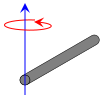abhi@eda
Member level 1
Simple question about on how much Torque is necessary by a DC motor to rotate a rotor arrangement..
This image below sums up my question more clear,its a hypothetical setup i know,but its just for my understanding

the length of each blade being 1.5 meter
As you can see,there's a electric motor,and it is connected directly to a shaft,and that shaft is connected to 3 blades ,where each blade weighs 1.5 kg,i know a gear can be used to increase the torque or increase RPM..but i want to understand it without confusion...
i want to calculate what amount of torque is to be produced by the motor to rotate the shaft,the torque reduces as the RPM goes up,but i want to find the initital torque needed to move it...
i want to know the steps or algorithm you could say
should i calculate the moment of inertia? or..?
please tell me the algorithm to calculate ,ill do it my self and try to find out the answer..thank you
- - - Updated - - -
the MI of the each blade


the weight of the each blade is 1.5 kg/14.7 Newtons
and the length of blade is 1.5 meter
therefore MI = (14.7 X 1.5^2)/3=11.025 Newtons
and as there are 3 blades its 11.025 N * 3 = 33.075N of total Moment of inertia on the rotational Axis..
so now the DC motor has to produce more than 33 Newtons per ... ?
so that it rotates the shaft a 0 RPM ,and if i produces any torque less than 33 Newtons per ... then the motor stalls and will never be able to start the rotation by itself..
am i right about this?
please correct me,this is aching my head,i am not from physics background...
This image below sums up my question more clear,its a hypothetical setup i know,but its just for my understanding

the length of each blade being 1.5 meter
As you can see,there's a electric motor,and it is connected directly to a shaft,and that shaft is connected to 3 blades ,where each blade weighs 1.5 kg,i know a gear can be used to increase the torque or increase RPM..but i want to understand it without confusion...
i want to calculate what amount of torque is to be produced by the motor to rotate the shaft,the torque reduces as the RPM goes up,but i want to find the initital torque needed to move it...
i want to know the steps or algorithm you could say
should i calculate the moment of inertia? or..?
please tell me the algorithm to calculate ,ill do it my self and try to find out the answer..thank you
- - - Updated - - -
the MI of the each blade


the weight of the each blade is 1.5 kg/14.7 Newtons
and the length of blade is 1.5 meter
therefore MI = (14.7 X 1.5^2)/3=11.025 Newtons
and as there are 3 blades its 11.025 N * 3 = 33.075N of total Moment of inertia on the rotational Axis..
so now the DC motor has to produce more than 33 Newtons per ... ?
so that it rotates the shaft a 0 RPM ,and if i produces any torque less than 33 Newtons per ... then the motor stalls and will never be able to start the rotation by itself..
am i right about this?
please correct me,this is aching my head,i am not from physics background...
Last edited:
